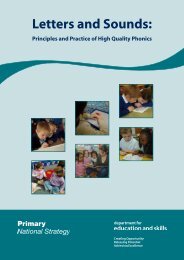What is the research evidence on writing? - Department for Education
What is the research evidence on writing? - Department for Education
What is the research evidence on writing? - Department for Education
Create successful ePaper yourself
Turn your PDF publications into a flip-book with our unique Google optimized e-Paper software.
Sentence combining <str<strong>on</strong>g>is</str<strong>on</strong>g> an effective strategy to improve <str<strong>on</strong>g>the</str<strong>on</strong>g> syntactic<br />
maturity of pupils in written Engl<str<strong>on</strong>g>is</str<strong>on</strong>g>h between <str<strong>on</strong>g>the</str<strong>on</strong>g> ages of 5 and 16 (Andrews<br />
et al, 2004a).<br />
Therapeutic teaching practices can be more effective than sensorimotor<br />
teaching practices in teaching pupils to improve poor hand<strong>writing</strong> (Dent<strong>on</strong> et<br />
al, 2006).<br />
Mult<str<strong>on</strong>g>is</str<strong>on</strong>g>ensory approaches to teaching hand<strong>writing</strong> may be more effective <strong>for</strong><br />
pupils in <str<strong>on</strong>g>the</str<strong>on</strong>g>ir sec<strong>on</strong>d year of school than cognitive approaches (Zwicker and<br />
Hadwin, 2009).<br />
There <str<strong>on</strong>g>is</str<strong>on</strong>g> some <str<strong>on</strong>g>evidence</str<strong>on</strong>g> that <str<strong>on</strong>g>the</str<strong>on</strong>g> use of ICT to teach spelling can be more<br />
effective than c<strong>on</strong>venti<strong>on</strong>al methods, but it <str<strong>on</strong>g>is</str<strong>on</strong>g> not stat<str<strong>on</strong>g>is</str<strong>on</strong>g>tically significant<br />
(Torgers<strong>on</strong> and Elbourne, 2002).<br />
For struggling writers and pupils with specific learning difficulties or Special<br />
Educati<strong>on</strong>al Needs (SEND), <str<strong>on</strong>g>the</str<strong>on</strong>g> approaches below are effective (Mas<strong>on</strong> et al, 2011;<br />
Santangelo and Olinghouse, 2009; Brooks, 2007; Humphrey and Squires, 2011):<br />
Use explicit, interactive, scaffolded instructi<strong>on</strong> in planning, composing and<br />
rev<str<strong>on</strong>g>is</str<strong>on</strong>g>ing strategies;<br />
Use cognitive strategy instructi<strong>on</strong>;<br />
For pupils with SEND, strategies that involve effective use and m<strong>on</strong>itoring of<br />
pupils’ data, which can be accessed by a range of stakeholders and can be<br />
reviewed by both teachers and parents, having structured c<strong>on</strong>versati<strong>on</strong>s<br />
with parents and a comprehensive range of interventi<strong>on</strong>s have been<br />
effective in ra<str<strong>on</strong>g>is</str<strong>on</strong>g>ing pupils’ achievement in Engl<str<strong>on</strong>g>is</str<strong>on</strong>g>h.<br />
<str<strong>on</strong>g>What</str<strong>on</strong>g> do we know about <str<strong>on</strong>g>the</str<strong>on</strong>g> gender gap in <strong>writing</strong>?<br />
Evidence suggests that boys per<strong>for</strong>m less well than girls in <strong>writing</strong>. Research<br />
<str<strong>on</strong>g>evidence</str<strong>on</strong>g> has identified a range of factors behind <str<strong>on</strong>g>the</str<strong>on</strong>g>ir underper<strong>for</strong>mance (Daly,<br />
2003; Estyn, 2008; DfES, 2007). These include:<br />
Factors related to <str<strong>on</strong>g>the</str<strong>on</strong>g> quality of teaching such as teaching grammar<br />
separately from c<strong>on</strong>textual<str<strong>on</strong>g>is</str<strong>on</strong>g>ed <strong>writing</strong>, inappropriate use of interventi<strong>on</strong>s,<br />
m<str<strong>on</strong>g>is</str<strong>on</strong>g>use of <strong>writing</strong> frames and a lack of c<strong>on</strong>necti<strong>on</strong> between oral and <strong>writing</strong><br />
work.<br />
School-level factors such as not offering children an active and free-play<br />
envir<strong>on</strong>ment which has been associated with more progress in reading and<br />
<strong>writing</strong>.<br />
Classroom-level factors such as ineffective use of ICT, setting and streaming.<br />
Behavioural and social-level factors.<br />
Factors related to <str<strong>on</strong>g>the</str<strong>on</strong>g> way less<strong>on</strong>s are c<strong>on</strong>ducted such as too much emphas<str<strong>on</strong>g>is</str<strong>on</strong>g><br />
<strong>on</strong> story <strong>writing</strong>, not giving boys ownership of <str<strong>on</strong>g>the</str<strong>on</strong>g>ir <strong>writing</strong>, a d<str<strong>on</strong>g>is</str<strong>on</strong>g>crepancy<br />
between boys’ reading preferences and <strong>writing</strong> topics, using ‘counting down’<br />
time strategies and a d<str<strong>on</strong>g>is</str<strong>on</strong>g>like by boys of drafting and figurative language.<br />
The following strategies <strong>for</strong> ra<str<strong>on</strong>g>is</str<strong>on</strong>g>ing boys’ per<strong>for</strong>mance have been identified (Daly,<br />
2003; Ofsted, 2005b):<br />
School and classroom level approaches such as using active learning tasks;<br />
appropriate approaches to d<str<strong>on</strong>g>is</str<strong>on</strong>g>cipline; target setting, m<strong>on</strong>itoring and<br />
4
















